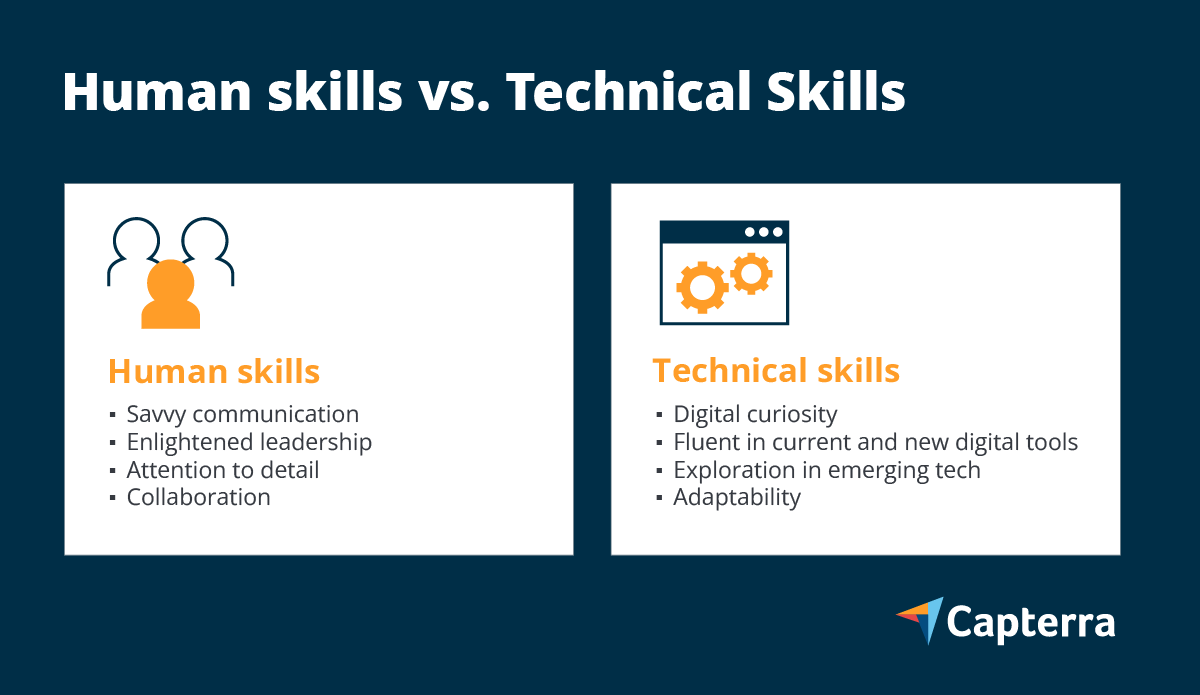Explore the meaning of "digital curiosity" with insights from an expert in HR and the future of work and learning.
/ An interview with Jeanne Meister
The following summarizes an interview facilitated by Capterra team member Kyle Rich and workplace futurist and HR expert Jeanne Meister. This conversation was edited for length and clarity.
Jeanne C. Meister likes to cite a shocking statistic: Greater adoption of technology has seen in-demand skills across jobs change drastically over the past few years—so much that 33% of the skills that were present in an average job posting in 2019 will not be needed by 2024.[1]
“The pace of change in the workplace has been accelerating,” says Meister, workplace futurist, executive vice president of Executive Networks, and Forbes contributor.[2] “And let’s face it, it’s not really the future of work, because it’s happening now.”
We sat down with Meister to talk about current and pending changes to the business landscape that will affect the workplace, and what that means for employers and employees alike.
In this article, we’ll talk about the hottest worker skills of the future and how—with talent being increasingly scarce—“learning how to learn” will become a top priority for employees. We’ll also discuss what smaller businesses can learn from larger ones when it comes to adopting new technologies to support the new ways of working.
Help wanted: A balance of human and technical skills

The most in-demand skills today—which will continue to be in demand in the future—are what Meister calls “human” skills. “They used to be called ‘soft skills,’ but they are actually too important to be called that anymore,” says Meister.
These skills include savvy communication and enlightened leadership, as well as the ability to pay attention to detail and collaborate as a team member.
Equally important are technical skills, but surprisingly Meister isn't focused on the usual office productivity suites or programming language capabilities. Instead, she says the successful worker of the future must have “digital curiosity.”
Just as intellectual curiosity is an essential quality in all upward mobility-seeking workers, so will digital curiosity be foundational to succeeding in the workplace of the future.
What is digital curiosity?
It means being fluent in how to use current and new digital tools while being curious to explore how emerging ones will impact your job.
Meister provided an example by discussing an online presentation she recently gave in which she had to move seamlessly between three different platforms.
“For me, as a boomer, that was a big change to manage,” says Meister. “I had to be fluent in all three mediums—Zoom, Teams, and StreamYard while delivering my presentation flawlessly.”
With talent scarce, learning becomes a priority
So important are employee intellectual and digital curiosity to business success that executives and company boards are taking note.
Today, Meister is seeing companies publish sophisticated in-depth “learning reports,” similar to the annual reports they deliver to investors. These reports focus on the value of the company’s investment in corporate learning and development.
“Why produce learning reports?” asks Meister. “Because the number one challenge in business today is lack of talent, and there’s tremendous urgency to upskill the talent you have to fit both current and future needs.”
These reports do a lot more than simply recount how many employees have gone through training and education programs. Instead, they show the business impact of that learning, and how it meets the organization’s strategic priorities.
“It’s a very exciting time to be in learning and development, now that it’s becoming much more strategic to business [success],” says Meister.
Does your skill supply fall short of your skill demand?
These three LMS features can help you start closing the skills gap at your organization.
Immersive software experiences can help with learning
Meister is seeing more immersive tools like augmented and virtual reality being used in workplace training and education. While these technologies started out primarily targeted at consumers, they have become more ubiquitous in business use cases and software.
“I’ve seen great use of virtual reality tools in diversity, equity, and inclusion training because you're able to simulate having difficult conversations in safe spaces,” says Meister.
She’s also seen it used successfully for new hire onboarding when a worker isn’t able to travel to the office for orientation. With virtual or augmented technologies, new employees can experience the business firsthand, and even walk through the headquarters building using a VR headset or avatar.
She is especially excited about using avatars to advance learning. “We still need to see a lot more innovation on immersive learning with avatars, so that we can offer workers the same experience of practicing conversations or practicing skills in a safe way, without the inconvenience of a headset,” says Meister.
Small businesses should take their inspiration from larger ones
How does all this apply to small and middle market companies? They should look to larger companies for inspiration, according to Meister.
For example, Delta Airlines today is much more focused on what skills people bring to the table rather than their degrees—or lack thereof—when hiring or promoting. The Delta Airlines “Skills First” program has eliminated the four-year degree requirement from positions where hands-on skills are more important than a degree.
Smaller businesses should follow suit.
“Many small businesses have jobs that require a four-year degree, and maybe they should take another look at those job descriptions to hire for skills rather than degrees.”


Jeanne Meister
Executive vice president of Executive Networks
Two things would happen: small businesses could widen the talent pool from which they can choose future employees, and they’d likely get a more diverse workforce.
Under it all, a thirst to learn
The underpinning of all of this? All workers should develop a thirst to keep learning, or as Meister says, “become a serial learner, where self-motivation, resilience and persistence, similar characteristics of a serial entrepreneur, will help you advance in your career.”
The one thing that has become evident in the past few years is the rapid acceleration of change. Whatever skills workers previously had will need to be updated. Workers should take that on themselves, of course. But employers have responsibilities also—to make training and development easily accessible.
“Companies that succeed will closely pair digital curiosity with continual learning,” says Meister.
Want to further your own education when it comes to your organization’s education and learning initiatives, while facilitating digital curiosity? These Capterra resources can help:
